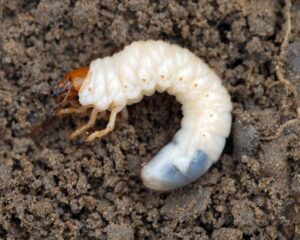
Grubs can be a major hassle for homeowners, but with our preventative grub control service throughout St. Charles, Lawn Doctor of Batavia-Aurora can take this difficult issue off your plate. Our preventative grub control service includes a product targeted to prevent the eggs from developing normally into larvae. It is the larval stage in the late summer into the fall when the larvae can cause the most turf damage.
Let’s review the basics of the beetle lifecycle. start by going over some key information about this lawn care threat.
What are Grubs?
Grubs are the offspring of Japanese beetles. When they hatch from their eggs, these small, C-shaped larvae will live in your soil and eat the roots of your turf. While you may see grubs in your lawn and landscape beds in the spring as the grubs are returning to the surface after over-wintering deeper in the soil, the spring grubs are generally sluggish and do not eat very much because they are preparing to pupate and pupating to fly off to feed and find a mate.
Also, because the turf is growing very vigorously in the spring, we generally do not see much damage from spring grubs. During the summer, the Japanese beetles will be very active and eat the leaves of many common landscape plants and trees. However, whether you see many adult Japanese beetles around your property does not mean you will be at more or less risk.
Japanese beetles can and do travel up to 5 miles in search of food and mates. They prefer sunny, warm locations in which to lay their eggs. They begin laying eggs around the July – August window and those eggs begin to develop into larvae, continuing the cycle. You will want to have the preventative grub application applied right before or at least during the primary egg laying window.
It is important to consider that the preventative grub control application does not eliminate grubs in the lawn and landscape. The preventative grub control application is designed to reduce the number of grubs below a “damage threshold”. The “damage threshold” is somewhere between 4 and 10 grubs per square foot. While the “damage threshold” sounds like a big range, healthy turf can withstand many more grubs than turf that is already weak and struggling.
How Do These Pests Hurt My Lawn?
Grubs cause direct turf damage by eating the roots of the turf. Grubs also attract animals, primarily skunks and raccoons that find and dig up the grubs.
The adult Japanese beetles can defoliate trees and shrubs. They prefer plants in the Rosacea family. However, most healthy plants can tolerate some defoliation.
Warning Signs of a Grub Infestation
Here are some signs that you may have an active grub infestation:
- Changes in turf color. Has your turf transformed from beautiful green to a bland yellow shade?
- Drought symptoms. Does your lawn seem dried out despite consistent watering?
- Loose Turf. Does your turf pull up easily and have you seen grubs under the loose sections of turf?
- Animal digging. Have you noticed any unexplained holes in your yard or seen animals digging around?
How Our Professional Grub Control in St. Charles Can Help
It is best to take steps to prevent grub damage. While we can apply curative products if you have noticed damage to your lawn, at that point the damage is done and most likely your lawn will require repair. We offer a preventative grub application to disrupt the egg development process. If you already have grub issues, we can also provide curative treatments to stop the current infestation. In addition, we can help repair turf damage caused by grubs.
Our preventative grub control service is covered by our leading satisfaction guarantee, so just let us know if you’re unhappy, and we’ll either come back to re-apply the previous treatment or refund your money. It’s just that simple.
Lawn Doctor of Batavia-Aurora operates throughout:
- St. Charles
- Naperville
- Batavia
- Wheaton
- Downers Grove
- Glen Ellyn
- Aurora
- Lisle
- Lombard
- West Chicago
- Winfield
- Geneva
- And the surrounding areas
For grub control in St. Charles, contact us today.
